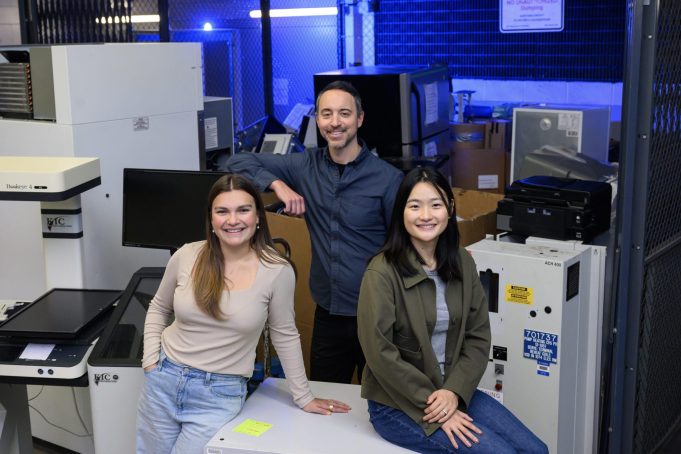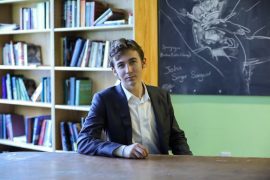In a unique research collaboration, students make the case for less e-waste

Brought together as part of the Social and Ethical Responsibilities of Computing (SERC) initiative within the MIT Schwarzman College of Computing, a community of students known as SERC Scholars is collaborating to examine the most urgent problems humans face in the digital landscape.
Each semester, students from all levels from across MIT are invited to join a different topical working group led by a SERC postdoctoral associate. Each group delves into a specific issue — such as surveillance or data ownership — culminating in a final project presented at the end of the term.
Typically, students complete the program with hands-on experience conducting research in a new cross-disciplinary field. However, one group of undergraduate and graduate students recently had the unique opportunity to enhance their resume by becoming published authors of a case study about the environmental and climate justice implications of the electronics hardware life cycle.
Although it’s not uncommon for graduate students to co-author case studies, it’s unusual for undergraduates to earn this opportunity — and for their audience to be other undergraduates around the world.
“Our team was insanely interdisciplinary,” says Anastasia Dunca, a junior studying computer science and one of the co-authors. “I joined the SERC Scholars Program because I liked the idea of being part of a cohort from across MIT working on a project that utilized all of our skillsets. It also helps [undergraduates] learn the ins and outs of computing ethics research.”
Case study co-author Jasmin Liu, an MBA student in the MIT Sloan School of Management, sees the program as a platform to learn about the intersection of technology, society, and ethics. “I met team members spanning computer science, urban planning, to art/culture/technology. I was excited to work with a diverse team because I know complex problems must be approached with many different perspectives. Combining my background in humanities and business with the expertise of others allowed us to be more innovative and comprehensive.”
Christopher Rabe, a former SERC postdoc who facilitated the group, says, “I let the students take the lead on identifying the topic and conducting the research.” His goal for the group was to challenge students across disciplines to develop a working definition of climate justice.
From mining to e-waste
The SERC Scholars’ case study, “From Mining to E-waste: The Environmental and Climate Justice Implications of the Electronics Hardware Life Cycle,” was published by the MIT Case Studies in Social and Ethical Responsibilities of Computing.
The ongoing case studies series, which releases new issues twice a year on an open-source platform, is enabling undergraduate instructors worldwide to incorporate research-based education materials on computing ethics into their existing class syllabi.
This particular case study broke down the electronics life cycle from mining to manufacturing, usage, and disposal. It offered an in-depth look at how this cycle promotes inequity in the Global South. Mining for the average of 60 minerals that power everyday devices lead to illegal deforestation, compromising air quality in the Amazon, and triggering armed conflict in Congo. Manufacturing leads to proven health risks for both formal and informal workers, some of whom are child laborers.
Life cycle assessment and circular economy are proposed as mechanisms for analyzing environmental and climate justice issues in the electronics life cycle. Rather than posing solutions, the case study offers readers entry points for further discussion and for assessing their own individual responsibility as producers of e-waste.
Crufting and crafting a case study
Dunca joined Rabe’s working group, intrigued by the invitation to conduct a rigorous literature review examining issues like data center resource and energy use, manufacturing waste, ethical issues with AI, and climate change. Rabe quickly realized that a common thread among all participants was an interest in understanding and reducing e-waste and its impact on the environment.
“I came in with the idea of us co-authoring a case study,” Rabe said. However, the writing-intensive process was initially daunting to those students who were used to conducting applied research. Once Rabe created sub-groups with discrete tasks, the steps for researching, writing, and iterating a case study became more approachable.
For Ellie Bultena, an undergraduate student studying linguistics and philosophy and a contributor to the study, that meant conducting field research on the loading dock of MIT’s Stata Center, where students and faculty go “crufting” through piles of clunky printers, broken computers, and used lab equipment discarded by the Institute’s labs, departments, and individual users.
Although not a formally sanctioned activity on-campus, “crufting” is the act of gleaning usable parts from these junk piles to be repurposed into new equipment or art. Bultena’s respondents, who opted to be anonymous, said that MIT could do better when it comes to the amount of e-waste generated and suggested that formal strategies could be implemented to encourage community members to repair equipment more easily or recycle more formally.
Rabe, now an education program director at the MIT Environmental Solutions Initiative, is hopeful that through the Zero-Carbon Campus Initiative, which commits MIT to eliminating all direct emissions by 2050, MIT will ultimately become a model for other higher education institutions.
Although the group lacked the time and resources to travel to communities in the Global South, which they profiled in the case study, they leaned into exhaustive secondary research, collecting data on how some countries are irresponsibly dumping e-waste. In contrast, others have developed alternative solutions that can be duplicated elsewhere and scaled.
“We source materials, manufacture them, and then throw them away,” Lelia Hampton says. A PhD candidate in electrical engineering and computer science and another co-author, Hampton jumped at the opportunity to serve in a writing role, bringing together the sub-groups research findings. “I’d never written a case study, and it was exciting. Now I want to write 10 more.”
The content directly informed Hampton’s dissertation research, which “looks at applying machine learning to climate justice issues such as urban heat islands.” She said that writing a case study that is accessible to general audiences upskilled her for the non-profit organization she’s determined to start. “It’s going to provide communities with free resources and data needed to understand how they are impacted by climate change and begin to advocate against injustice,” Hampton explains.
Dunca, Liu, Rabe, Bultena, and Hampton are joined on the case study by fellow authors Mrinalini Singha, a graduate student in the Art, Culture, and Technology program; Sungmoon Lim, a graduate student in urban studies and planning and EECS; Lauren Higgins, an undergraduate majoring in political science; and Madeline Schlegal, a Northeastern University co-op student.
Taking the case study to classrooms around the world
Although PhD candidates have contributed to previous case studies in the series, this publication is the first to be co-authored with MIT undergraduates. Like any other peer-reviewed journal, before publication, the SERC Scholars’ case study was anonymously reviewed by senior scholars drawn from various fields.
The series editor, David Kaiser, also served as one of SERC’s inaugural associate deans and helped shape the program. “The case studies, by design, are short, easy to read, and don’t take up lots of time,” Kaiser explained. “They are gateways for students to explore, and instructors can cover a topic that has likely already been on their mind.” This semester, Kaiser, the Germeshausen Professor of the History of Science and a professor of physics, is teaching STS.004 (Intersections: Science, Technology, and the World), an undergraduate introduction to the field of science, technology, and society. The last month of the semester has been dedicated wholly to SERC case studies, one of which is: “From Mining to E-Waste.”
Hampton was visibly moved to hear that the case study is being used at MIT but also by some of the 250,000 visitors to the SERC platform, many of whom are based in the Global South and directly impacted by the issues she and her cohort researched. “Many students are focused on climate, whether through computer science, data science, or mechanical engineering. I hope that this case study educates them on environmental and climate aspects of e-waste and computing.”


